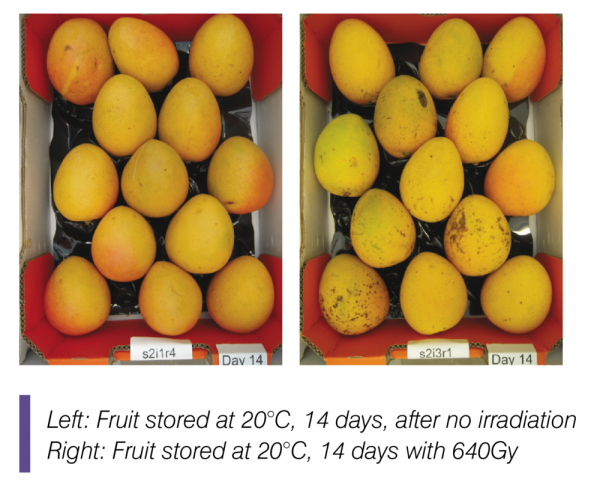Another piece in the irradiation puzzle
Noel Ainsworth, Principal Supply Chain Horticulturist, Department of Agriculture and Fisheries
Predicting the impact of irradiation on mango quality is important to enable exporters to gauge the potential for and to manage the risk associated with using irradiation as a disinfestation treatment protocol. There are a number of variables that can affect the extent of fruit damage (e.g. skin browning, lenticel spotting and delayed loss of green colour) following irradiation treatment. These may include the variety, the environmental and field management conditions during fruit growth and harvesting, supply chain variables and post treatment storage conditions such as time, temperature, ethylene and CO2.
In November, the Queensland Department of Agriculture and Fisheries undertook an internally funded ‘Innovation Opportunity’ trial (thanks go out to Manbulloo for supplying the fruit and Steritech for paying for the irradiation treatment). The trial undertook detailed dose mapping of a commercial sized pallet using ‘Kensington Pride’ mango in Mod12 trays suitable for cost effective export, to better understand the likely variation in irradiation dose and fruit damage anticipated in irradiated pallets of fruit. This trial also examined the effect of irradiating fruit pre-ripened to average colour stage 3 (range of 2-4 or 10-70% yellow colour) using two post irradiation storage regimes. Fruit receiving three different dose ranges across the pallet were assessed separately (plus a control) with four trays (of 13 fruit per tray) assessed for each treatment. Combined, this was designed to help an exporter identify the potential for fruit damage, and where in the pallet the most severe damage might occur.

Dosimetry illustrated that the irradiation service provider’s process of using pallet density to define the length of exposure to reach a desired minimum irradiation dose, worked well. However it also reinforced the risk that the dose required to ensure the minimum dose (400Gy) to all fruit can result in some fruit receiving more than 850Gy. This equates to a Dose Uniformity Ratio (DUR) of well over 2.0. This can pose risk of the fruit being damaged, depending on the variables mentioned above. The dose mapping and quality assessment suggests that the fruit at greatest risk of quality loss are those in trays at the front or back (rather than in the middle) of the pallet. These trays should be targeted during export market quality inspections at arrival.
Not surprisingly, the use of 12°C storage for the first seven days (then 20°C for the remaining 11 days of assessment) post irradiation held back the ripening of the fruit by 2 and 5 days as indicated by fruit firmness and skin colour, respectively when compared with fruit held at 20°C for the entire 18 day assessment period. The cooler storage condition also delayed the expression of lenticel spotting and skin browning by about 3 days.
The irradiation dose did not have a significant effect on fruit ripening for this pre-ripened fruit, but all three irradiation doses (440Gy, 640Gy and 840Gy) resulted in higher (but similar) lenticel spotting than the control treatment (0Gy). Fruit receiving 640Gy and 840Gy did show a greater level of skin browning than those receiving 440Gy or 0Gy. Cool storage delayed the start of visible skin browning by 3 days (from 7 to 10 days after irradiation) for the 640Gy and 840Gy treatments, while skin browning in the 440Gy treatment did not start to express until day 14 after irradiation.
These results have the following implications in relation to irradiation disinfestation of ‘Kensington Pride’:
- Previous research indicated that irradiation damage can be reduced by treating fruit that have been pre-ripened to at least colour stage 3.
- There is still considerable variation in doses received by fruit throughout the pallet, with the highest doses received by fruit mid height in the pallet at the front or the back.
- Even the minimum dose of 440Gy increased lenticel spotting, while doses from 640Gy increased skin browning. Inspecting the fruit in the locations that received the highest doses will give a good indication of maximum likely damage.
- Low temperature holding delayed both ripening and damage expression but did not affect the loss of quality at the ripe stage.
- Previous research suggests that fruit harvested soon after or during rain are more likely to develop lenticel damage, and these should not be irradiated for export.
The planned use of out-turn quality assessments in the export markets together with monitoring of conditions in the supply chain are both key to understanding the interplay of factors affecting quality, maximising saleability and securing long term profits.
Please contact Noel Ainsworth (noel.ainsworth@daf.qld.gov.au or 0409 003 909) for further information.